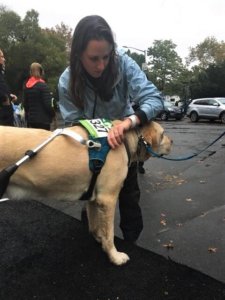Main Menu
By Dr. Beth Brenninkmeyer, DVM, Guiding Eyes Chief Veterinary Officer
While our Guiding Eyes Running Guide Dog Teams are out training in local parks, we often hear the same questions: How far are you going? (Usually between three and five miles.) Where did you get those great boots? (From our partner Ruffwear.) And most importantly, is that safe for the dog? At Guiding Eyes, maintaining the health and wellbeing of these world-class canines is our primary concern from the day our litters are born – for it is the health of the dog that ensures the safety of the graduate they will one day guide and protect.
Running Prevents Canine Obesity
When addressing the issue of running safely with dogs, we begin with the health benefits. One of the biggest health concerns our canine companions face is obesity, with body weight at least 15% above ideal. Global clinical surveys from the Association for Pet Obesity Prevention indicate that greater than 50% of the canine population is considered overweight or obese. Obesity is a major contributor to long-term health issues; it can significantly shorten a dog’s life span and reduce quality of life as secondary medical conditions develop in the face of excessive stress on organ systems and joints.
Fortunately, obesity is largely preventable through proper diet and exercise. It is essential for all dogs – particularly working dogs – to participate in regular activity in order to maintain physical and mental acuity. This health benefit to our Running Guide Dogs is one half of the equation of running as a team with their graduate, as the graduate also reaps the rewards of regular exercise.
Monitoring Dogs for Safe Running
We’ve all seen the disclaimer directed at humans, “Before starting an exercise program, consult with your doctor.” At Guiding Eyes, we follow that advice for our canines as well. To ensure that our dogs are physically sound for guide work as well as running, we evaluate radiographs of all of our dogs’ hips, knees and elbows at approximately 16 months, before they begin to run.
Guide dogs that participate in the Running Guides Program are chosen for their overall stamina, focus and desire to run. In the program, dogs learn to avoid obstacles and navigate a route at a comfortable pace. Our graduates also receive training on how to recognize injury in dogs. Dogs can be stoic, and may continue to run through subtle injuries, so we advise graduates on recognizing subtle changes in pace or hesitation.
Our Running Guides program follows the American Veterinary Medical Association’s Guidelines for Safe Running:

To keep you and your pet safe when running, follow these simple rules:
As our New York City Half Marathon Running Guide Dogs relay through the 13.1 mile race on March 17, our team of Guiding Eyes volunteers and veterinarians will be on hand to provide check-ups and ensure the team’s hydration, health and safety. Whether you are running with your dog in a world-class race or just taking a quick jog around the park, following the AVMA guidelines for safe running will help ensure that your dog stays healthy for years to come.